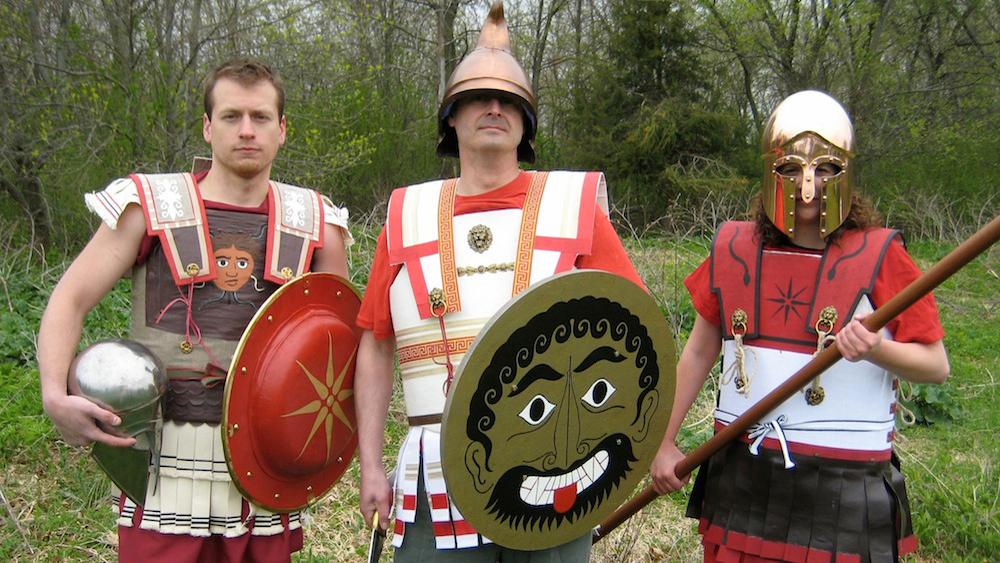Why did Greek warriors go to war wearing what today looks like a linen mini-dress?
From left to right: Scott Bartell, William Schwartz, Abbie O’Toole. All were students of Gregory Aldrete and participated in the “Linothorax Project.”
It's eerie what military technology can do these days.
But in ancient Greece, they thought they were cutting edge when they had developed the linothorax. What's a linothorax, you ask? Well, lino refers to linen and thorax means the chest.
Now imagine eye an ancient Greek warrior, his sword in the air, an olive branch on his head, and around his middriff, one of these pleated shirt-skirts, if you will. That shirt-skirt is a linothorax. But the linothorax wasn't a fashion statement — it was a suit of armor.
So, how could what amounts to a kitchen apron serve the same purpose as kevlar?
For years historians have pondered that.
It's difficult to research linothoraxes because they are made of bio-degradable material. Few remains have been found at historic sites. But they are mentioned in texts — and we can see them on vases and paintings.
University of Wisconsin Green Bay Professor Gregory Aldrete and a group of his students used these drawings and ancient texts to make versions of the linothorax, and research why they were effective.
They documented their work in the "Linothorax Project" and published a book on the subject called "Reconstructing Ancient Linen Body Armor: Unveiling the Linothorax Mystery."
But replicating these creations wasn't an easy task. Aldrete and his team discovered that linothoraxes are made using several layers of linen and rabbit glue — yes, made out of the skin of rabbits.
"We had to recreate these using materials that were as close as possible to what they would have had in the ancient world," he says.
They had to get their hands on linen that was hand-woven and hand-sewn but also grown and harvested by traditional methods. That meant they had to grow their own linen. Which they did.
After creating the armor, they put it to the test. They made square slabs of the linen and shot arrows at them. They even put it on themselves and tested them out.

"Our bottom line result was, if you were wearing one of these things in the ancient world between 600 and 200 BC, you would have been safe from any kind of arrows out there," Aldrete says.
Some major advantages of these linen linothoraxes was that they were light-weight, flexible and offered good protection.
"In the 100-degree Mediterranean sun, if you're traipsing around ancient Persia or Greece, it made a lot of difference if you were wearing linen armor versus bronze," he explains. "If you're encased in a bronze breast plate, it would bake you."
Aldrete says the idea of using layers of linen (or any material) and gluing them together to create a tough, resistant material has been used for centuries. And it's still used today. Some of the bullet-proof vests used by armies and police forces around the world have been created using similar concept.
Now, Aldrete is getting questions about the linothorax armor from Hollywood. But he says the oddest request came from a designer of role playing games who was creating a game based on a zombie apocalypse.
He wanted to know if this armor would be good protection against a zombie bite.
"After thinking about it for a bit, I had to say, yes, it probably would," Aldrete says.
It's eerie what military technology can do these days.
But in ancient Greece, they thought they were cutting edge when they had developed the linothorax. What's a linothorax, you ask? Well, lino refers to linen and thorax means the chest.
Now imagine eye an ancient Greek warrior, his sword in the air, an olive branch on his head, and around his middriff, one of these pleated shirt-skirts, if you will. That shirt-skirt is a linothorax. But the linothorax wasn't a fashion statement — it was a suit of armor.
So, how could what amounts to a kitchen apron serve the same purpose as kevlar?
For years historians have pondered that.
It's difficult to research linothoraxes because they are made of bio-degradable material. Few remains have been found at historic sites. But they are mentioned in texts — and we can see them on vases and paintings.
University of Wisconsin Green Bay Professor Gregory Aldrete and a group of his students used these drawings and ancient texts to make versions of the linothorax, and research why they were effective.
They documented their work in the "Linothorax Project" and published a book on the subject called "Reconstructing Ancient Linen Body Armor: Unveiling the Linothorax Mystery."
But replicating these creations wasn't an easy task. Aldrete and his team discovered that linothoraxes are made using several layers of linen and rabbit glue — yes, made out of the skin of rabbits.
"We had to recreate these using materials that were as close as possible to what they would have had in the ancient world," he says.
They had to get their hands on linen that was hand-woven and hand-sewn but also grown and harvested by traditional methods. That meant they had to grow their own linen. Which they did.
After creating the armor, they put it to the test. They made square slabs of the linen and shot arrows at them. They even put it on themselves and tested them out.

"Our bottom line result was, if you were wearing one of these things in the ancient world between 600 and 200 BC, you would have been safe from any kind of arrows out there," Aldrete says.
Some major advantages of these linen linothoraxes was that they were light-weight, flexible and offered good protection.
"In the 100-degree Mediterranean sun, if you're traipsing around ancient Persia or Greece, it made a lot of difference if you were wearing linen armor versus bronze," he explains. "If you're encased in a bronze breast plate, it would bake you."
Aldrete says the idea of using layers of linen (or any material) and gluing them together to create a tough, resistant material has been used for centuries. And it's still used today. Some of the bullet-proof vests used by armies and police forces around the world have been created using similar concept.
Now, Aldrete is getting questions about the linothorax armor from Hollywood. But he says the oddest request came from a designer of role playing games who was creating a game based on a zombie apocalypse.
He wanted to know if this armor would be good protection against a zombie bite.
"After thinking about it for a bit, I had to say, yes, it probably would," Aldrete says.
We want to hear your feedback so we can keep improving our website, theworld.org. Please fill out this quick survey and let us know your thoughts (your answers will be anonymous). Thanks for your time!
